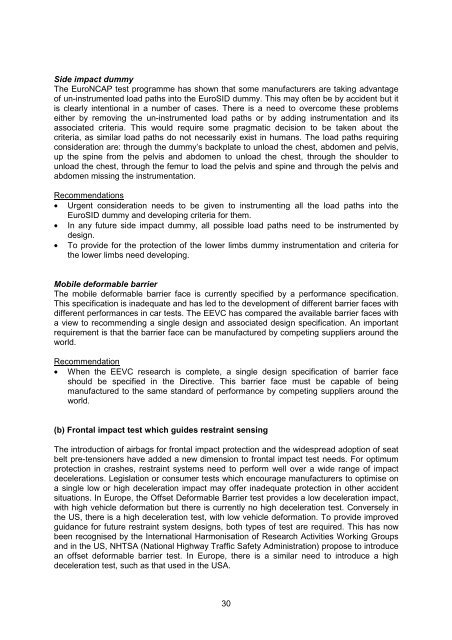PRIORITIES FOR EU MOTOR VEHICLE SAFETY DESIGN
priorities for eu motor vehicle safety design - ETSC
priorities for eu motor vehicle safety design - ETSC
Create successful ePaper yourself
Turn your PDF publications into a flip-book with our unique Google optimized e-Paper software.
Side impact dummy<br />
The EuroNCAP test programme has shown that some manufacturers are taking advantage<br />
of un-instrumented load paths into the EuroSID dummy. This may often be by accident but it<br />
is clearly intentional in a number of cases. There is a need to overcome these problems<br />
either by removing the un-instrumented load paths or by adding instrumentation and its<br />
associated criteria. This would require some pragmatic decision to be taken about the<br />
criteria, as similar load paths do not necessarily exist in humans. The load paths requiring<br />
consideration are: through the dummy’s backplate to unload the chest, abdomen and pelvis,<br />
up the spine from the pelvis and abdomen to unload the chest, through the shoulder to<br />
unload the chest, through the femur to load the pelvis and spine and through the pelvis and<br />
abdomen missing the instrumentation.<br />
Recommendations<br />
• Urgent consideration needs to be given to instrumenting all the load paths into the<br />
EuroSID dummy and developing criteria for them.<br />
• In any future side impact dummy, all possible load paths need to be instrumented by<br />
design.<br />
• To provide for the protection of the lower limbs dummy instrumentation and criteria for<br />
the lower limbs need developing.<br />
Mobile deformable barrier<br />
The mobile deformable barrier face is currently specified by a performance specification.<br />
This specification is inadequate and has led to the development of different barrier faces with<br />
different performances in car tests. The EEVC has compared the available barrier faces with<br />
a view to recommending a single design and associated design specification. An important<br />
requirement is that the barrier face can be manufactured by competing suppliers around the<br />
world.<br />
Recommendation<br />
• When the EEVC research is complete, a single design specification of barrier face<br />
should be specified in the Directive. This barrier face must be capable of being<br />
manufactured to the same standard of performance by competing suppliers around the<br />
world.<br />
(b) Frontal impact test which guides restraint sensing<br />
The introduction of airbags for frontal impact protection and the widespread adoption of seat<br />
belt pre-tensioners have added a new dimension to frontal impact test needs. For optimum<br />
protection in crashes, restraint systems need to perform well over a wide range of impact<br />
decelerations. Legislation or consumer tests which encourage manufacturers to optimise on<br />
a single low or high deceleration impact may offer inadequate protection in other accident<br />
situations. In Europe, the Offset Deformable Barrier test provides a low deceleration impact,<br />
with high vehicle deformation but there is currently no high deceleration test. Conversely in<br />
the US, there is a high deceleration test, with low vehicle deformation. To provide improved<br />
guidance for future restraint system designs, both types of test are required. This has now<br />
been recognised by the International Harmonisation of Research Activities Working Groups<br />
and in the US, NHTSA (National Highway Traffic Safety Administration) propose to introduce<br />
an offset deformable barrier test. In Europe, there is a similar need to introduce a high<br />
deceleration test, such as that used in the USA.<br />
30



